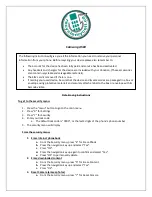
7
1989 GSM was moved into the ETSI organization
GSM name changed to Global System for Mobile communications.
1990 DCS1800(edited GSM900) specification developed
In 1981 analogue cellular was introduced and at about the same time there was a joint Franco-German
study looking at digital cellular technology and the possibility of making a pan-European system..
In 1982 a special working committee, Groupe Spécial Mobile (GSM), was formed within the CEPT to look
at and continue the Franco-German study. In 1986 the working committee was taken a step further by
establishment of a permanent nucleus of people to continue the work and create standards for a digital system
of the future. About a year later, the memorandum of understanding, or MoU, as it is referred to, was signed by
over 18 countries. It stated that they would participate in the GSM system and get it into operation by 1991.
In 1989 GSM was moved into the ETSI (European Telecommunications Standards Institute) organization.
Once under the control of ETSI, the GSM system had it's name changed to Global System for Mobile
communications. The committees working on the system changed from GSM to SMG (Special Mobile Group).
These changes avoided confusion between the system name (GSM), and the people working the specification
(SMG). It also brought the naming in line with the official working language of ETSI (English).
In 1990 the GSM specification developed an offshoot - DCS1800. The Original DCS1800 specifications
were developed simply as edited versions of the GSM900 documents. Interest in GSM quickly spread outside
Europe. In 1992 Australia became the first non-European country to join the MoU. Since then, many other
Asian countries have adopted GSM. There's now a Pan-Asian MoU, investigating international roaming
agreements.
The Phase II specification for GSM has now been defined, merging GSM900 and DCS1800 documents,
number of new features are added to the system, along with many minor adjustments. The next step, Phase
II+ defines the addition of specific new services such as data and fax to GSM and DCS1800.
5.2
:
GSM Network
This is the GSM system. The Mobile Stations (MS), both hand held (portables) and traditional mobiles in a
car, talk to the Base Station System (BSS) over the RF air interface. The Base Station System (BSS) consists
of a Base Transceiver Station (BTS), and a Base Station Controller (BSC). It's typical for several BTS to be
located at the same site, producing 2 to 4 sectored cells around a common antenna tower. BSC's are often
connected to BTS via microwave links.
The BSC to BTS link is called the Abis interface. Typically 20 to 30 BTS will be controlled by one BSC. A
number of BSS's would then report back to the Mobile Switching Center (MSC) which controls the traffic
among a number of different cells. Each (MSC) will have a Visitors Location Register (VLR) in which mobiles
that are out of their home cell will be listed, so that the network will know where to find them. The MSC will also
be connected to the Home Location Register (HLR), the Authentication Center (AUC), and the Equipment
Identity Register (EIR) so the system can verify that users and equipment are legal subscribers. This helps
avoid the use of stolen or fraud mobiles. There are also facilities within the system for Operations and
Maintenance (OMC) and Network Management (NMC) organizations. The Mobile Switching Center (MSC)
also has the interface to other networks such as Private Land Mobile Networks (PLMN) and Public Switched
Telephone Networks (PSTN) and ISDN networks.
5.3
:
GSM Air Interface
:
In GSM, the GSM transmission between MS and BS is Radio Communication, let’s introduce the GSM Air
Interface.
1
):
Channel Plans
:
Содержание W420
Страница 1: ...Voxtel Repair Manual Item W420 ...
Страница 23: ...23 3 LDO circuit ...
Страница 24: ...24 Cameramodule control circuit ...








































